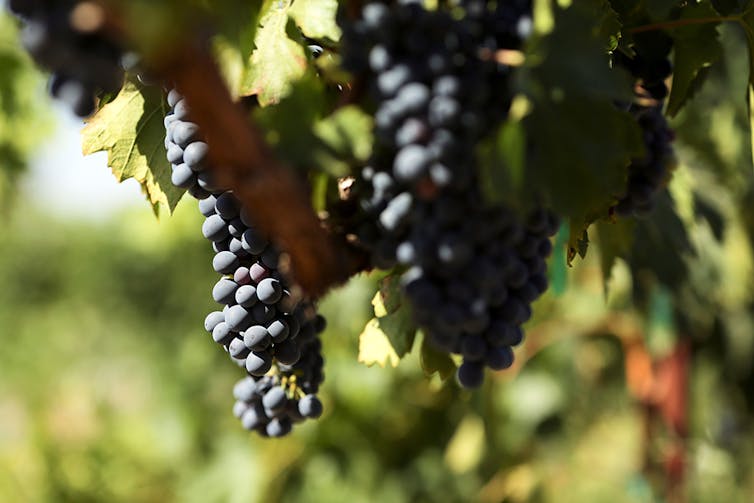Should California winemakers be worried about China's tariffs?
- Written by Julian M. Alston, Director of the Robert Mondavi Institute Center for Wine Economics, University of California, Davis
California’s vintners and grape growers are among the latest potential victims in the escalating trade spat between the U.S. and China.
Responding to U.S. plans to impose import duties on goods from China, the Chinese Ministry of Commerce reciprocated[1] by introducing new tariffs on 128 U.S. products, including an additional 15 percent import tariff on wine.
Wine producers in California are concerned about the immediate and longer-term implications of this new tariff, on top of those already in place. Reports have already begun to circulate[2] about orders being canceled, redirected or renegotiated as a result.
How worried should U.S. winemakers be?
The US wine industry
The U.S. is a major player in the global wine industry both in terms of consumption and production.
Americans consumed 3.59 billion liters of wine[3] in 2016, or about 11.1 liters per person. About a third of that was imported.
In terms of production, the U.S. ranks fourth[4] after Italy, France and Spain – making more than 3 billion liters[5] in 2016. California produced about 85 percent of that.
While the vast majority of U.S. wine is consumed domestically, about 10 percent is shipped overseas. In 2017, the U.S. exported 380 million liters[6] of wine worth US$1.46 billion. Canada was the top destination, importing 28 percent of the total, followed by the U.K. with 15 percent, Hong Kong at 8 percent and Japan with 6 percent.
China’s small share
China, for its part, imports quite a bit of wine. Very little, however, comes from the U.S.
China imported some $2.37 billion worth of wine in 2016, most of which came from the European Union. Only $76 million[7], or 2.2 percent, was American.
That puts China sixth among top destinations for U.S. wine exports, with a share of about 5 percent.
These figures underestimate[8] the true value somewhat because more than half of Hong Kong’s imports are then shipped or smuggled to China. Even allowing for these adjustments, Chinese consumption of U.S. wine makes up less than 1 percent of the total value of American production.
It’s clear that at the moment China is not all that important to most California wine producers. Why then are U.S. wine producers anxious about new tariffs disrupting trade to this relatively minor market?
It’s all about the future. Although per capita consumption of wine in China remains very low, China is the world’s fastest-growing wine market and is expected to soon become the second largest, after the U.S.
From 2000 to 2016, Chinese wine consumption soared[9] from 219 million liters in 2000 to 1.24 billion liters in 2016. Some observers estimate[10] growth was even higher. Much of that consumption was imported – especially in the premium wine segment.
Economists who have studied these markets[11] project further significant growth in China’s demand for wine, including premium wine imports.
This would make getting pushed out of China especially troubling at a time when global per-capita wine consumption has been declining, especially in Europe.
Already at a disadvantage
Even without the new tax, U.S. exporters were facing a tilted playing field that would have constrained the potential for increasing California’s market share.
Without the new tariffs, China already collected a tariff of 14 percent on most U.S. wine – though it can reach as high as 20 percent in some categories. In contrast, wine from some countries[12], such as Chile, Georgia, New Zealand and, starting next year, Australia, enter China duty-free.
With the new tariff in effect, most American wines will incur duties of 29 percent.
Hong Kong, however, does offer a back door to U.S. wine. The China-governed island phased out its own steep tariffs on wine imports a decade ago. This has created an incentive for smuggling.
 Grapes at the University of California at Davis await picking.
Reuters/Robert Galbraith
Grapes at the University of California at Davis await picking.
Reuters/Robert Galbraith
A market lost?
So what does all this mean?
Given the small share of total U.S. wine currently going to China, the new tariff would not likely have a material effect on the American wine industry, whether in terms of domestic prices or producer bottom lines. Still, it will be disruptive for particular businesses especially in the near term.
The real concern for American wine producers is that high tariffs applied today may make U.S. wine too expensive and cause them to miss out as hundreds of millions of Chinese middle-income consumers increase their wine consumption over the next decade.
More broadly, if the trade spat escalates to a trade war, serious damage will be done to all of U.S. agriculture, including grape and wine producers. Even more troubling, if the loss of trade causes broader damage to the U.S. economy, it could even affect demand for California wine in its most important market: the United States.
References
- ^ reciprocated (www.nytimes.com)
- ^ Reports have already begun to circulate (www.lodinews.com)
- ^ consumed 3.59 billion liters of wine (www.cambridge.org)
- ^ ranks fourth (www.wineinstitute.org)
- ^ making more than 3 billion liters (www.wineinstitute.org)
- ^ exported 380 million liters (www.cambridge.org)
- ^ $76 million (atlas.media.mit.edu)
- ^ figures underestimate (www.adelaide.edu.au)
- ^ Chinese wine consumption soared (www.adelaide.edu.au)
- ^ Some observers estimate (www.adelaide.edu.au)
- ^ Economists who have studied these markets (www.cambridge.org)
- ^ wine from some countries (www.adelaide.edu.au)
Authors: Julian M. Alston, Director of the Robert Mondavi Institute Center for Wine Economics, University of California, Davis
Read more http://theconversation.com/should-california-winemakers-be-worried-about-chinas-tariffs-94607

